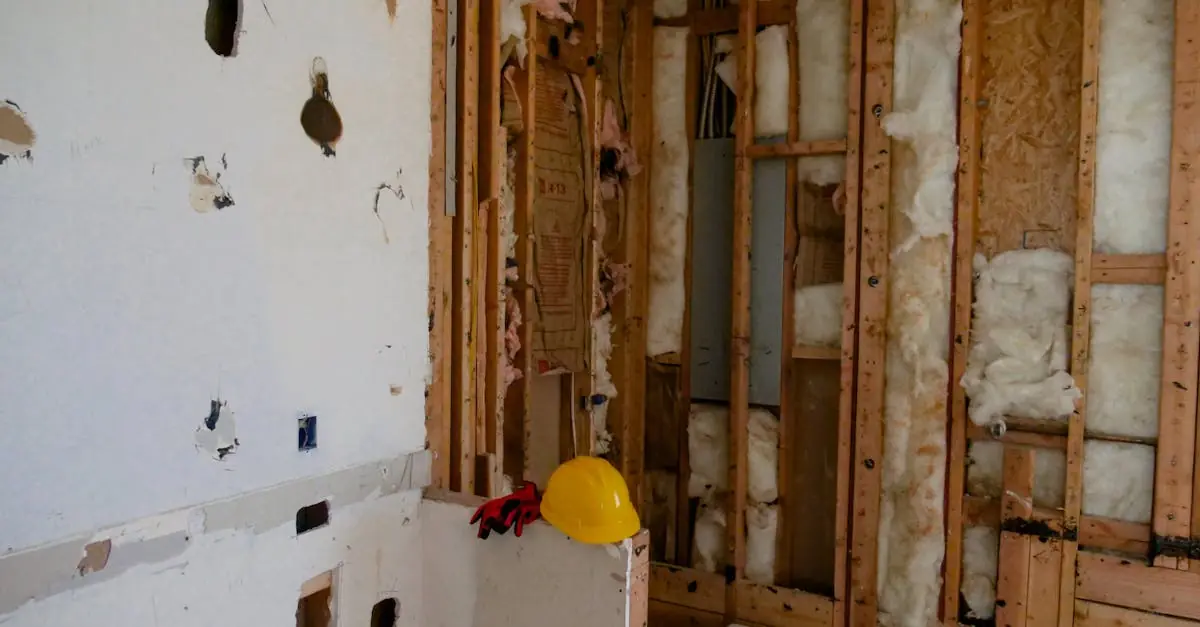Table of Contents
ToggleIn a world where comfort and energy efficiency reign supreme, multi-layer insulation is the unsung hero lurking behind the scenes. Think of it as the superhero of home energy solutions—keeping the heat in during winter and the cool air in during summer, all while wearing a stylish cape of reflective materials. Who knew staying cozy could be this high-tech?
Overview of Multi-Layer Insulation
Multi-layer insulation plays a significant role in enhancing energy efficiency within homes. This advanced solution consists of multiple layers of reflective materials designed to minimize heat transfer. It effectively retains warmth during cold months while preventing the intrusion of heat in warmer seasons.
Reflective surfaces, typically positioned within the layers, reflect radiant heat away from interiors. These surfaces often include materials like aluminum foils, which significantly boost insulation performance. Each layer contributes to reducing thermal conductivity, which leads to improved energy conservation.
Energy savings from multi-layer insulation can reach up to 30 percent annually, depending on climate and application. Homes equipped with this insulation maintain consistent indoor temperatures, resulting in enhanced comfort and decreased heating and cooling costs.
Installation occurs in various areas, including attics, walls, and floors, adapting to diverse architectural designs. Professionals typically assess insulation needs based on specific home characteristics and the local climate. This adaptability makes multi-layer insulation a practical choice for various residential settings.
By incorporating multi-layer insulation into energy efficiency strategies, homeowners pave the way for sustainable living. This solution not only supports eco-friendly practices but also provides long-term financial benefits. Enhanced comfort, reduced energy costs, and environmental responsibility all stem from the implementation of these advanced insulation technologies.
Benefits of Multi-Layer Insulation
Multi-layer insulation offers significant advantages that enhance home comfort and efficiency. These benefits include improved energy efficiency and substantial cost savings.
Energy Efficiency
Energy efficiency derives from a multi-layer insulation system’s ability to reduce heat transfer. This insulation minimizes heat loss during winter months, ensuring that indoor spaces remain warm. During summer, it reflects heat away from the home, contributing to cooler interiors. Research indicates that multi-layer insulation can improve overall energy performance by up to 30 percent. This level of efficiency is crucial, particularly in areas with extreme temperature fluctuations. Additionally, the reflective qualities of materials like aluminum foils optimize thermal performance, maintaining consistent indoor temperatures year-round.
Cost Savings
Cost savings emerge as a direct outcome of enhanced energy efficiency. Homeowners experience reduced energy bills when using multi-layer insulation, thanks to lower heating and cooling demands. Over time, substantial annual savings accumulate, making this insulation a smart investment. Local and federal incentives may also apply, further lowering installation expenses. In many cases, the initial investment pays for itself within a few years due to the ongoing reductions in utility costs. Ultimately, incorporating multi-layer insulation leads to both financial and environmental benefits, supporting a sustainable lifestyle while maintaining comfort.
Applications of Multi-Layer Insulation
Multi-layer insulation serves various industries, primarily focusing on energy efficiency and temperature regulation.
Aerospace Industry
Multi-layer insulation plays a pivotal role in aerospace applications. It effectively protects spacecraft and satellites from extreme temperature fluctuations. By minimizing heat transfer, this insulation ensures that critical instruments operate within specified temperature ranges. Researchers have designed multi-layer insulation systems specifically for space missions, utilizing lightweight materials for optimal performance. The insulation enables spacecraft to withstand both scorching heat and frigid cold without compromising functionality. As a result, engineers often choose this technology for launching and operating satellites.
Construction Sector
Multi-layer insulation also finds extensive use in the construction sector. Builders incorporate it into residential and commercial structures to enhance energy efficiency. By using layers of reflective materials, multi-layer insulation significantly reduces heat loss during winter and minimizes heat gain during summer. This technology helps to maintain stable indoor temperatures, which is crucial for occupant comfort. Notably, various climates benefit from multi-layer insulation’s ability to lower energy consumption. Energy savings can exceed 30 percent depending on geographical and building characteristics. Hence, integrating this insulation strategy in new construction projects presents clear long-term advantages.
Materials Used in Multi-Layer Insulation
Multi-layer insulation utilizes various materials to enhance thermal performance. These materials are pivotal for energy efficiency in homes and industries.
Common Insulation Materials
Aluminum foil serves as a primary component. It reflects radiant heat, improving insulation effectiveness. Polyethylene bubbles are another common choice; they provide lightweight cushioning and thermal resistance. Fiberglass layers also feature prominently; they trap air, offering excellent heat retention. Materials like polyester film add durability while maintaining flexibility. Each of these components plays a crucial role in minimizing heat transfer, contributing significantly to energy savings in residential and commercial applications.
Innovative Developments
Recent advancements focus on enhancing the performance of multi-layer insulation. Aerogel technology introduces exceptionally lightweight materials with superior thermal resistance. Researchers are also exploring nanotechnology to create reflective coatings that further reduce heat transfer. Smart materials that adjust to environmental changes enhance insulation effectiveness. Innovations in manufacturing techniques have led to the development of thinner, more efficient layers, which optimize performance in limited spaces. Continuous improvements in material science promise to enhance both energy efficiency and sustainability, solidifying multi-layer insulation’s position as a leading solution for thermal management.
Challenges and Limitations
Multi-layer insulation presents specific challenges and limitations that impact its effectiveness. Installation complexity often arises, especially in homes with unique designs or hard-to-reach areas. Adequate professional installation becomes critical, as improper fitting may compromise the insulation’s performance and benefits.
Cost considerations also play a significant role. Initial expenses for materials and labor can deter some homeowners from choosing this advanced insulation technology. Although long-term energy savings may offset these costs, the upfront investment can be a barrier for many.
Moisture management is another concern. Inadequate ventilation can lead to moisture buildup, potentially resulting in mold growth or damage to structural components. Homeowners need to ensure proper air circulation to mitigate these risks.
Limited effectiveness in certain climates may also occur. While multi-layer insulation excels in regions with extreme temperature fluctuations, its benefits may diminish in more temperate climates. Therefore, local climate conditions can influence the overall performance and suitability of this insulation type.
Durability is a factor that shouldn’t be overlooked. Over time, some materials may degrade, reducing insulation efficiency. Regular inspections and maintenance are crucial to ensure ongoing effectiveness.
Market availability can vary. Not all retailers stock the specific multi-layer insulation products tailored for unique applications. Researching and sourcing the right materials becomes necessary for optimal performance.
Regulatory standards and building codes can also present obstacles. Compliance with local regulations requires careful planning and awareness of permitted materials and techniques. Ensuring adherence to these standards is vital for safe installation and long-term effectiveness.
Conclusion
Multi-layer insulation stands out as a vital component in enhancing home energy efficiency. Its ability to retain warmth in winter and reflect heat in summer makes it an invaluable asset for homeowners seeking comfort and cost savings. With potential energy savings of up to 30 percent, this advanced insulation solution not only improves indoor climates but also promotes sustainable living.
By investing in multi-layer insulation, homeowners can enjoy reduced energy bills and contribute to environmental responsibility. While there are challenges to consider, such as installation complexities and moisture management, the long-term benefits far outweigh the initial concerns. Embracing this technology paves the way for a more energy-efficient future, making multi-layer insulation a wise choice for anyone looking to optimize their living space.




